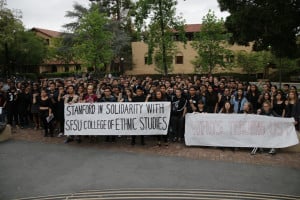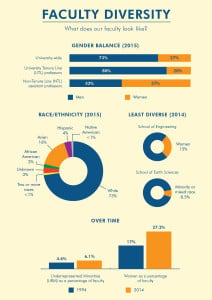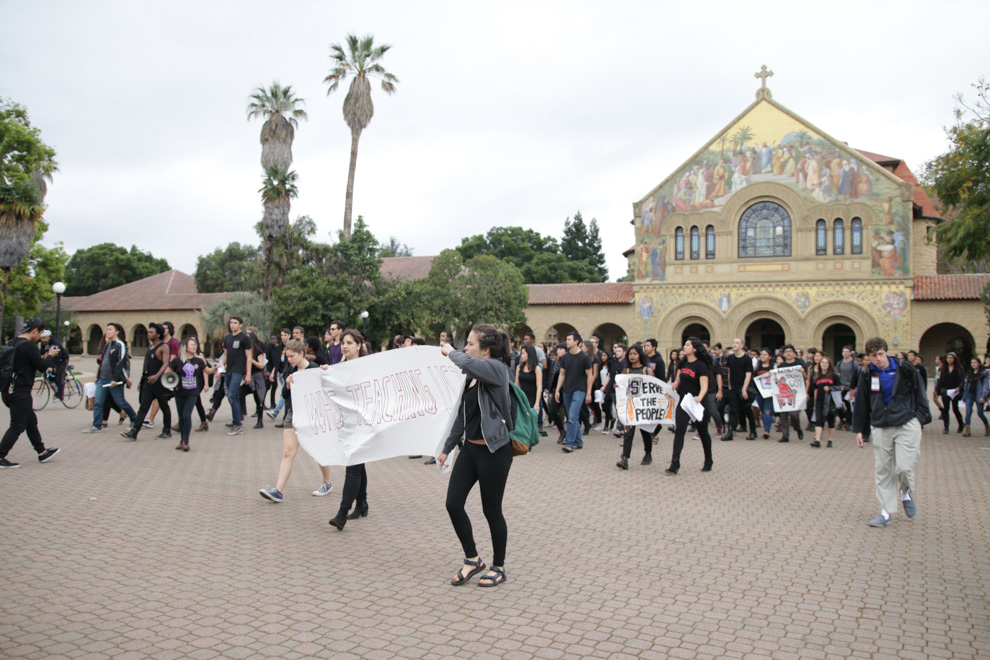On March 14, the student group Who’s Teaching Us (WTU) sent a list of demands to Stanford’s administration. Two weeks later, on March 27, The Stanford Review leaked an draft copy of those demands, triggering a dialogue across campus about diversity at Stanford.
WTU’s official demands cover a breadth of issues, but six focus on improving faculty diversity. They demand that the University: hire at least 10 tenure-track ethnic studies professors, one of whom in each department must be hired through the Faculty Development Initiative (FDI); develop a required identity and cultural humility training program for faculty; select non-white, non-cisgender-male individuals as Stanford’s next president and provost; amend the Acts of Intolerance protocol to create a platform for reporting and tracking micro aggressions from faculty; require all departments to publicly release detailed tenure data by race and ethnicity; and double the number of faculty of color – especially those belonging to underrepresented minorities (URM) – in departments outside of the School of Humanities and Sciences.
“Stanford’s faculty is not diverse enough to properly support its student body,” WTU states in their demands. “To truly support students of color, Stanford needs more faculty of color.”
Data shows that Stanford’s faculty has grown increasingly diverse over the past decade, but the pace of change has been slow. Stanford’s administration has openly expressed its dedication to improving faculty diversity and its willingness to work with WTU by providing “structured conversations” around the core issues in their demands. However, WTU has questioned Stanford’s commitment to substantive change.

While administrative perspectives on diversity issues found much common ground with WTU, they sometimes diverged on the source of diversity shortcomings and how to approach fixing them.
The numbers
Stanford’s faculty was 73 percent white and 73 percent male as of fall 2015. More detailed statistics on faculty composition are available for the 2013-2014 school year, when the Office of the Vice Provost for Faculty Development and Diversity (VPFDD) released its “Report on the Faculty.”
According to that report, from 2004-2014 the percentage of minority faculty increased by 6.5 percent. However, the percentage of underrepresented minority faculty did not increase at all, and only increased by 1.5 percent from 1994-2014.
The report reveals that minority representation varies widely across departments and schools.
“The Graduate School of Education (17.9%) and Law School (11.5%) have the highest percentages of URM faculty members, while URM faculty in the School of Earth Sciences, H&S Natural Sciences, [the School of Medicine (SOM)] and [the Stanford Linear Accelerator Center (SLAC)] are no more than 5% respectively,” the report states.
Lack of racial diversity is not the only problem. Gender diversity among the faculty has improved only marginally over the past decade. According to the report, from 2004 to 2014 the University’s proportion of female faculty increased by four percentage points.
Currently, 27.2 percent of faculty at Stanford are female. However, several departments and schools fall particularly behind in equal representation for both genders: SLAC with 8 percent women, the Graduate School of Business (GSB) with 22 percent, the School of Engineering with 15 percent and the Departments of Natural Sciences with 18 percent. The School of Education, with a 43 percent female faculty, comes the closest to parity.
This data is neither new nor shocking to many within both the administration and the faculty.
“We have a very diverse undergraduate student body,” said Matthew Snipp, senior associate vice provost for faculty development and diversity, Burnet C. and Mildred Finley Wohlford professor in the School of Humanities and Sciences and former director of the Center for Comparative Studies in Race and Ethnicity (CCSRE). “We have an increasingly diverse graduate student body. And not a lot of progress in a diverse faculty that looks like the undergraduates and, increasingly, the graduate students.”
According to Snipp, who reached out to WTU with other members of the administration, increasing faculty diversity is more difficult than increasing student diversity.
“The undergraduate student body turns over every four years,” he said. “The graduate student population turns over probably every six to 10 years depending on the department. Faculty, they turn over about every 20 or 30 years. So, it takes a lot longer.”
“We are a little more diverse than we used to be,” Snipp said. “But it’s been glacial in terms of the progress.”
Push for progress
WTU is not alone in seeking to push this “glacial” progress forward.
Dean of the School of Engineering Persis Drell, for example, believes that increasing diversity of both faculty and students within the University, and her school particularly, is imperative for Stanford’s future success.
“In our strategic planning process last spring, increasing faculty and student diversity in the school emerged as the most important cultural issue that we need to address,” Drell said in an email to The Daily.
The administration even welcomes the added pressure from students to increase faculty diversity, according to Karen Cook, vice provost for faculty development and diversity and Ray Lyman Wilbur Professor of Sociology.
WTU and leaders from the VPFDD fundamentally agreed that Stanford has work to do. They also agreed that the change must begin with what is called the pipeline problem: There are not enough people of color and women entering academia, especially in certain fields.
“[Underrepresented minorities and women] don’t … have enough mentorship,” said Colin Kimzey ’17, a member of the WTU coalition. “There are not enough people who look like them who can mentor them, and their non-minority colleagues, like white men, are not really willing to mentor them. They don’t feel like taking that on.”
Kimzey also criticized a lack of guidance in the “grad student pipeline.”
Snipp, too, characterized the pipeline issue as one of his main frustrations, mentioning graduate students in particular.
“I have been here at Stanford now almost 20 years, and the number of students of color that I have managed to persuade to go onto graduate school I can count on one hand,” Snipp said.
According to Cook, Stanford recognizes that drawing underrepresented minorities and women into academia is critical for creating a diverse faculty in the future – and the University is working to do just that, she said.
She cited the Diversifying Academia, Recruiting Excellence (DARE) program, which since 2008 has provided two-year fellowships encouraging doctoral students from diverse backgrounds to pursue faculty careers.
Differing views

While University initiatives have understood increasing diversity in terms of increasing the number people color and women who pursue academia, WTU believes that faculty diversity is more than a pipeline problem.
WTU argues that “cultural taxation” at Stanford makes it more difficult for faculty of color and women to get tenure. Kimzey described cultural taxation as the burden placed on faculty of color and sometimes female faculty to take on extra responsibilities, such as advising minority students and participating actively in diversity work on campus.
“If you are an underrepresented faculty member at Stanford, you have a lot of other responsibilities besides research, which is what the departments look at when they are giving out tenure,” Kimzey said. “[Underrepresented minority faculty] are pressured to take on student advisees because these students want people who look like them to advise them, and they need that support in the University system.”
However, Snipp – a URM faculty member himself – disagreed with WTU about the prevalence of such cultural taxation on Stanford’s campus.
“I think that [cultural taxation] happens less here because there is a real sense that we have to protect junior faculty,” Snipp said. “The tenure bar here is very high. We all know that it is high. I think there is a general sense, at least among the faculty I know here, that you just don’t expect junior faculty to [take on extra responsibilities relating to diversity and advising] and you discourage them … I have done that on occasion.”
According to Kimzey, in addition to cultural taxation and the pipeline problem, WTU is also concerned with the inefficient decentralization of current programs for increasing faculty diversity – specifically FDI, which works to recruit faculty whose research focuses on the study of ethnicity and race. The initiative began in 2007 and has since led to the hiring of 14 new faculty members.
Kimzey said that various academic departments do not necessarily make use of resources like FDI.
“You can talk to the administration and get these things done, but the departments still have their autonomy and they tend towards perpetuating how they generally work,” Kimzey said.
However, the faculty and administration involved with FDI disagreed with this claim, saying that departments have been willing to work with them to increase faculty diversity.
“We have never been turned down, not once, by a dean or by the provost’s office,” said Snipp, who has led FDI since its launch. “If we can find somebody and the department is happy with them, and they are happy with us, then we get to hire them. We have never been told no.”
Cook said that there is no cap on the number of new hires that FDI and another program, the Faculty Incentive Fund (FIF), can make.
“One of [WTU’s] demands is that they’d like 10 new positions,” Cook said. “We have as many positions as we can fill. I actually don’t want a cap.”
“The resources that Hennessy and Etchemendy made available have really made a difference,” Cook said, referring to FDI.
Cook particularly lauded the commitment of departments and schools, especially the School of Engineering and its current and previous deans, as a driving force behind increasing the number of women within the faculty.
Women made up 8 percent of Stanford’s engineering faculty in 2001; in 2013-2014, they made up 15 percent. Still, this number is only about half the University-wide percentage.
While WTU and the administration may disagree on the success of programs and the ultimate causes of slow growth in faculty diversity, the most divisive point of contention between WTU and the administration is diversity at the very top of Stanford’s leadership.
Every president of the University has been a white male, and WTU openly expressed its disappointment with the recent appointment of Marc Tessier-Lavigne, a white man, as Stanford’s next president.
“We are not a University of white men,” Kimzey said. “We haven’t been for a long time, and it is ridiculous that the president does not reflect that.”
But faculty and administrators are focusing on what the next president will do for increasing diversity, rather than his race and gender.
“I think people who are pre-judging [Tessier-Lavigne] based on his gender and ethnicity should at least give him a chance to get into the job and do something,” Snipp said. “Then, if he doesn’t, we can hold his feet to the fire.”
But WTU’s dissatisfaction with the next president stems not just from his being white and male, Kimzey said. WTU also believes that he lacks the necessary qualifications for the job.
“I think we would find qualification being any sort of credentials with diversity, which he does not have,” Kimzey said. “He may be a white man, but he is also a white man who has never, in his long career, seemed to have done anything … that relates to a positive contribution to diversity wherever he has gone.”
Cook and Snipp both disagreed.
“My sense is that … [diversity] was an important issue in the selection of the next president,” Cook said. “I think that if that weren’t true he wouldn’t have been defined so highly as a great candidate for the position.”
Looking to the future
Despite disagreements, WTU and the administration both share a nominal commitment to addressing diversity, or the lack thereof.
Currently, Stanford is working to improve diversity among new hires, particularly on the departmental level. Drell said that, although there is “no single solution,” the School of Engineering is striving to improve its faculty search process.
“For instance, the deans are now going to every search committee in the School of Engineering and explicitly encouraging hiring not just on demonstrated achievement, but on potential,” Drell said. “We are also talking more about unintended biases that creep into the hiring process because we know that if we cannot talk about difficult issues, they are not going to get fixed.”
According to Cook, similar programming on unconscious bias in hiring is offered through her office. Cook also said that the School of Medicine requires that all members of search committees go through training about diversity issues.
So far, WTU remains unsatisfied with the University’s efforts, but the organization will nevertheless need to work with the administration to institute the changes it wants to see in Stanford’s faculty.
“We have these dreams of what we want the University to be,” Kimzey said. “They see that and they also have their own ideas of how they want the University to change.”
Contact Blanca Andrei at [email protected].
